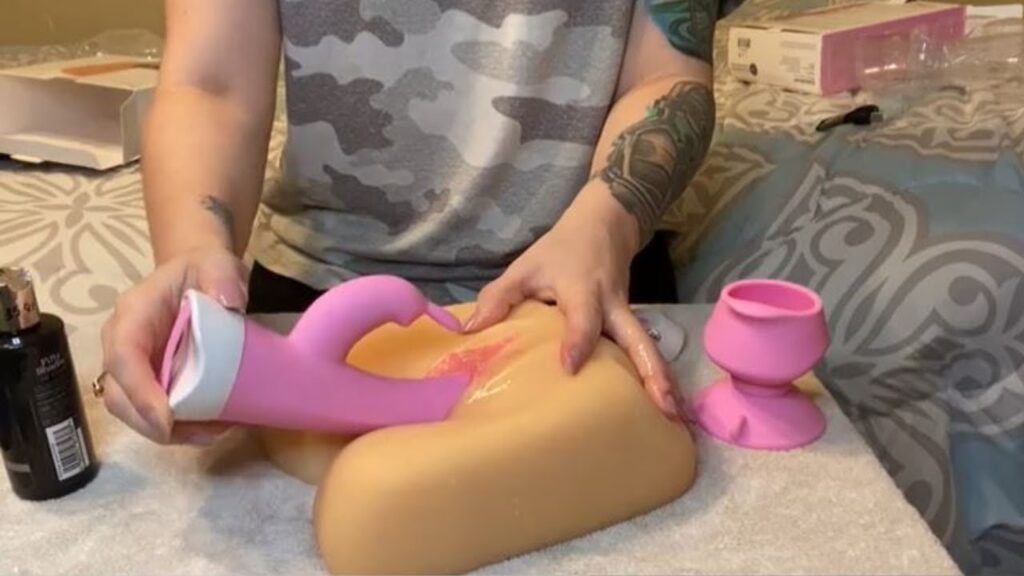
Sex toys are like a lot of other products in that they collect bacteria, which is why it’s important to clean them regularly.
It’s especially important to clean dildos before use or if you’re using them on a partner who has an STI. But not everyone follows through on this basic hygiene rule, so it’s a good idea to learn how to clean your sex toys before you start playing with them.
Disinfecting
Sex toys can be cleaned with water and mild soap, though how you clean them varies from toy to toy. They can also be sterilized by heating them to a high temperature to kill bacteria and germs that can build up on them.
Sterilizing your sex toys is a safer, more thorough way to get rid of any germs that have built up on them, and it also helps prevent them from getting re-infected when you put them back in your pocket or bag. However, it’s important to make sure you do this correctly, as if not done properly, your dildo could end up storing a ton of bacteria that can cause sexually transmitted infections.
Porous materials such as jelly rubber, rubber, PVC, vinyl, and TPE/TPR are tough to clean because they contain microscopic holes that allow bacteria and fungi to seep into them. Unlike non-porous materials like glass, steel, and body-safe silicone, these porous toys can’t be safely boiled as they are more likely to melt with the high temperatures needed to sanitize them, says Nicole Fretz, MS, MPH, a sexual health and wellness educator and certified gynecology nurse at Columbia University Medical Center in New York City.
But if you do decide to boil your dildo, be careful to follow the manufacturer’s instructions on how long you should leave them in the water. You should also check the dildo’s material to see whether it is body-safe and non-porous.
The most common types of sex toys are made from non-porous materials such as steel, glass, and body-safe silicone. But not all are, and some can be contaminated with viruses or bacteria that can cause sexually transmitted diseases, according to May.
That’s why it’s so important to clean your dildo and sanitize it before and after each use, Leone says. Bacteria such as Gardnerella vaginalis, which can lead to bacterial vaginosis, and Neisseria gonorrhoeae, which can spread chlamydia, don’t typically live longer on hard surfaces than a day or two after their exposure, she adds.
Fortunately, many sex toys are designed to be easily disinfected or sanitized so that they don’t have any potential to harbor harmful microorganisms. If you’re unsure about what kind of cleaner is safe to use on your dildo, ask the manufacturer or look up online to find out which products are appropriate. Most of these products will provide a list of ingredients and safety precautions on the bottle.
Surface Cleaning
Whether you’ve just purchased your first dildo or have years of experience with them, it’s important to know how to properly clean and store them. This will extend their life, keep your genitals safe and prevent damage.
Some sex toys are made of porous materials that can easily hold bacteria, according to Laurie Mintz, Ph.D., author of Sex Toys and Sensual Play. These include TPR, TPE, jelly rubber, hard plastic, latex and elastomer toys as well as “silicone blend” products, PVC, leather, and some types of stones.
Porous sex toys are harder to clean than nonporous ones, so it’s important to understand the material before you start cleaning them. You can do this by reading the manufacturer’s instructions or asking your retailer for advice.
Then, choose a method that works for your particular product. Some sex toys can be cleaned by simply submerging them in warm water and a mild detergent, while others may require boiling or bleaching.
You can also use a dishwasher for this process, but you’ll need to follow the manufacturer’s instructions to ensure that you remove any remaining germs from the water. Expect to spend about one to three minutes per toy (not including air-drying time) when surface cleaning them.
Once you’re done, dry the toy thoroughly. For example, don’t leave it on a towel or table to dry because the heat might warp it.
Alternatively, you can place the toy in an air-drying pouch for a few hours. This is particularly helpful for nonporous materials, like metal and borosilicate glass.
Another common option for cleaning these sex toys is to spray them with a sex toy cleaner. This won’t kill all of the bacteria in the pores, but it can be a good starting point.
Finally, you can try sanitizing them with rubbing alcohol. This will help to remove any lubricants, body fluids, and dirt dust or lint picked up from being dropped or stored somewhere open.
Regardless of how you clean your sex toys, it’s always a good idea to restock them as soon as you notice that they look dirty or don’t function as they once did. This will save you from paying for a replacement in the future and can be a fun sensual ritual to perform with your partner.
Cleaning Removable Parts
When it comes to dildos, cleanliness is key. Besides the fact that it will keep you and your partner’s intimate areas germ-free, it can also increase the life of your dildo and make it much more enjoyable to use.
The first step to cleaning a dildo is to remove it from its case or packer. Some dildos can be removed with ease, while others need to be detached using tools. This can include a pair of tweezers, a needle and thread, or even a pair of pliers.
It’s important to clean the dildo before and after every use, because if you don’t it can degrade over time. That’s not just a bad thing for your dildo, but it can also make you and your partner less comfortable, and it might have an impact on the quality of your playtime.
You can also use a microfiber cloth to wipe down the dildo after every use to ensure that it stays as shiny and fresh as possible. But be sure to wash it well afterward to prevent lint from accumulating on the toy or in your body.
One of the best things about dildos is that they can come in all sorts of shapes and sizes. Some are shaped like swords, tentacles, or even sasquatches, which will provide fun and exciting stimulation for you and your partner.
There are also a wide variety of materials used to make sex toys, and some are more difficult than others to keep clean. But there are a few tips and tricks that will make the job a lot easier for you, while still keeping your dildo as good as new.
Drying
Drying your sex toys is one of the most important parts of ensuring they remain safe to use. If a toy is not properly dried, bacteria can thrive and spread on it.
A good rule of thumb is to dry all your toys before you store them in a box or drawer for storage. This ensures that they don’t contaminate other items and stay safe to use for as long as possible.
If you want to clean your dildo, you can use a mild soap or antibacterial wipes to remove any dirt and debris from it. However, you should avoid using harsh soaps as they can irritate your skin and cause itching or swelling later on.
You may also need to wash your dildo before storing it to make sure that it is completely free of germs. This is because bacteria can live for up to 24 hours on a hard surface like a dildo, according to the University of California, San Francisco, clinical instructor of medicine, Bianca Alba, MPH.
While it’s not always easy to clean dildos, you should try to do so as soon as you can after use, especially if they are made from delicate materials, such as TPE and silicone. During the manufacturing process, some manufacturers will apply talcum powder to the dildo’s surface in order to prevent it from drying out.
After washing your dildo, you should place it on a clean towel and allow it to air-dry. This is the best way to dry most sex toys as it will help to avoid lint from sticking to the product and leaving behind any unwanted residue, explains Deysach.
You can also air-dry dildos in front of a fan to speed up the drying process and get them ready for play sooner. This method is ideal for sex toys with textured sleeves, as the nooks and crannies can be difficult to dry with other methods.


